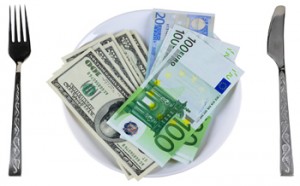Making Your Weight Loss Surgery Diet More Affordable

A common concern for weight loss surgery patients is that healthy foods have the reputation of being expensive. You might fear that the commitment to years of healthy eating will be outside of your budget, especially if you paid for weight loss surgery out of pocket. But, you can eat healthy on a budget.
Junk Food May Seem Cheaper at First
Your pre-surgery eating habits may seem cheap. For $1, you can order a burger, taco, burrito, sandwich or fries from at value menu at most fast food places. Candy bars, chips, crackers, snack cakes and sodas from vending machines also cost about $1 each. For $5, you can get an entire pizza, a fast food value meal with a burger, fries, and a drink, or the workplace cafeteria’s daily lunch special with a fried chicken sandwich, onion rings or fries and a drink. Almost everywhere, ordering larger portion sizes and extra side dishes gives you bigger discounts.
These options seem inexpensive at first glance. For example, if you compare the cost of a pizza to an alternative of ordering grilled chicken and a salad for lunch at a sit-down restaurant, the pizza is cheaper. Similarly, a doughnut from a convenience store is far cheaper than a fresh fruit salad from the same convenience store. However, you can make better use of your food dollar.
Convert Your Pre-WLS Food Dollar into Post-WLS Nutrition
Most of the foods on your diet before weight loss surgery may have been relatively inexpensive, but the total cost may have been more than you think. Consider this sample day to see how your post-surgery diet can continue to fit within your budget.
-
Breakfast: Before WLS ($5): coffee and a bagel with cream cheese and smoked salmon. After WLS: 2 hard-boiled eggs, a cup of cantaloupe and a slice of turkey ham ($2). Save $3.
-
Morning Snack: Before WLS ($3): a muffin and a coffee. After WLS ($1): string cheese and a half an apple. Save $2.
-
Lunch: Before WLS ($7): a sub sandwich, chips, and a drink. After WLS: tuna, whole-wheat crackers and a cup of cooked cauliflower ($3). Save $4.
-
Afternoon Snack: Before WLS ($2): a soda and a bag of cookies. After WLS: peanut butter and carrot sticks ($1). Save $1.
-
Dinner: Before WLS ($4): steak, mashed potatoes, a dinner roll with butter, a green salad, and cheesecake. After WLS: ground turkey, green beans, almonds and a half a banana ($3). Save $1.
Eat In More Often
Save money by preparing more of your own food and eating less often at restaurants or fast food chains. Another benefit is that you have more control over what you eat when you prepare it yourself. You can keep your homemade food simple and still have a nourishing diet. Consider these restaurant meals and home-made alternatives to try. Each of the suggested alternatives is simple to make and it is more nourishing and less costly than the restaurant choice.
- A sugar-sweetened, flavored coffee beverage plus a cinnamon roll versus fat-free yogurt and fresh or frozen fruit.
- A burger, fries, and drink versus a salad with lettuce, grilled chicken breast and pecans.
- Breadsticks and a dip, soup, and fettuccine Alfredo versus broiled salmon with steamed spinach.
- Soda, an alcoholic beverage, or another beverage versus water.
Shopping Strategies to Cut Costs and Improve Nutrition
Without caution, you can spend a lot and leave the supermarket with plenty of unhealthy foods. On the other hand, a plan and some practice can help you stretch your food dollar while you stock up on healthy foods from the grocery store.
- Use a list. This helps you avoid impulse purchases of high-calorie, high-cost foods. It also ensures that you remember key ingredients so that you do not have to get them at the last minute from an expensive convenience store.
- Watch the sales. Staples in your kitchen might include tuna, peanut butter, whole-wheat pasta, beans, frozen fruits and vegetables, frozen chicken and lean beef and spices. Stock up on these non-perishables when they are on sale.
- Buy in bulk. Purchase larger packages, since they are usually cheaper than single-serving packages. Measure out single-portion servings when you are ready to use them. This is an especially good strategy for family-sized packs of chicken and fish, for snack products such as nuts and whole-grain crackers, and for yogurt.
- Buy store brands. They usually taste the same as the national brands and are far less costly. Dairy products, cereals and frozen and canned goods are good candidates.
- Check out your neighborhood. Discount stores and ethnic stores often have certain high-quality products for far cheaper than the chain supermarkets. Check for fresh produce, spices, and condiments at ethnic and discount stores.
- Buy in season. Out-of-season fruits and vegetables can be prohibitively expensive, but in-season ones can be on sale and higher quality. Some fruits and vegetables that are relatively consistent year-round are apples, cabbage, carrots, mushrooms, lettuce, onions, and celery.
Your new diet after weight loss surgery requires major adjustments to your eating habits. Practice and also planning are necessary so you can get the protein and other nutrients you need, avoid the foods that are bad for you, and lose the weight you want. With so much to worry about after WLS, you do not want to have to worry about the cost of the healthy foods you need. These tips can help put you on the path to healthy eating within a reasonable budget.


Christie68 1
Posted
Great article!
Share this comment
Link to comment
Share on other sites